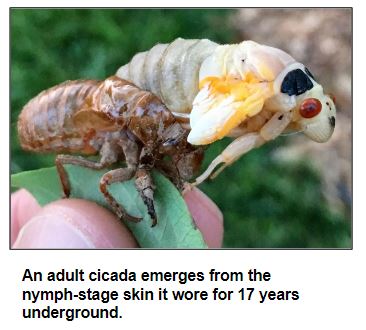May 21, 2021
Even though 17 years have zipped by since their last visit, no one is putting out welcome mats for the periodical cicadas that are about to take Indiana by swarm. The Hoosier state is considered one of the country's major hot spots for the 17-year emergence of the type of cicadas known as Brood X.
"The bugs will show up pretty much anywhere there are mature trees, and the males will unleash loud mating calls that will fill the late spring with buzzing music," the Evansville Courier-Journal reported in a heads-up article about the insects that are typically considered pests, to say the least. According to the Courier-Journal, early pioneers of European heritage, alarmed by the swarms, incorrectly assumed that cicadas were like locusts and would ravage their crops, giving cicadas their "first jolt of bad publicity."
So who can separate fact from myth about these critters?
Hoosier History Live is summoning a top national insect expert who happens to be based in our own backyard.
 Dr. Tom
Turpin, the Purdue
University professor emeritus of entomology who
created the annual Bug
Bowl competition (touted as "the world's largest
insect-themed event") on the West
Lafayette campus, will be Nelson's guest. For
decades, he wrote On Six
Legs, a popular column (and starting in 2008, podcast)
for the Purdue
Extension service.
Dr. Tom
Turpin, the Purdue
University professor emeritus of entomology who
created the annual Bug
Bowl competition (touted as "the world's largest
insect-themed event") on the West
Lafayette campus, will be Nelson's guest. For
decades, he wrote On Six
Legs, a popular column (and starting in 2008, podcast)
for the Purdue
Extension service.
Among the questions about cicadas that Dr. Turpin says he plans to tackle: Why do so many emerge at the same time? Will eating periodical cicadas kill my dog or cat, or make them sick? and How long will periodical cicadas be singing?
"Singing" isn't the word most people use to describe the loud, persistent noise made by the 17-year cicadas. According to a recent analysis in USA Today, experts standing a few feet away from swarms have measured their sounds at 96 decibels, "slightly higher than a low-flying airplane, which can hit about 80 decibels."
In any case, Dr. Turpin has a long track record of exploring insects that are regarded as annoying or even repulsive. Cockroach races and cricket-spitting contests have been frequent events at the Bug Bowl.
"People are conditioned not to like insects," Dr. Turpin said in 2017 upon his retirement from the Purdue faculty.
Also in 2017, he was a Hoosier History Live guest for a show titled Insect heritage: The As to Zzzzzs. He has shared insights about insects with ABC News' Good Morning America, Time magazine and other national media.

Their emergence is part of a mating process, as are their distinctive sounds. After mating with male cicadas, females lay their eggs on twigs and branches in trees.
That means areas thick with mature trees tend to be where swarms of cicadas emerge. In central Indiana, Eagle Creek Park, the Geist Reservoir area and Fort Harrison State Park are likely sites for heavy swarms. Elsewhere in the state, Shades State Park, McCormick's Creek State Park and the Hoosier National Forest are probable hot spots, according to a recent report in the Indianapolis Star.
Feeling a little creeped out at the thought of the cicadas' return?
Take solace in the fact that the periodical cicadas - which date back to the dinosaur era - will have a fleeting presence. After one month or six weeks at most, Brood X cicadas will no longer be above ground - at least not for another 17 years.